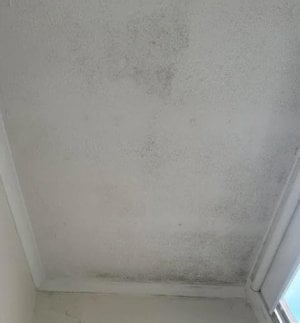‘It’s not liveable’ – Renter discovers dangerous find in their property
- Replies 9
Finding a new rental property and settling in can be a challenging and often time-consuming process. You might be wondering what your neighbours will be like or if there will be unexpected surprises in your new home.
One Sydney renter recently found out the hard truth when they moved into a property, only to discover ‘unliveable’ conditions due to black mould – this is the kind of story we at the SDC hope none of our members will ever have to experience.
An anonymous Sydney renter detailed their awful experience in a popular Facebook group dedicated to renters.
After just two months into the lease, they noticed black mould growing on the walls and ceiling of their new home, which has since sparked significant health issues for them, including respiratory problems, itchy eyes, and a skin rash.
Desperately seeking help and advice, the renter tried various measures to get rid of the mould, such as cleaning it and using dehumidifiers in every room, but to no avail.
The situation got worse when they were advised by mould cleaners that there were significant issues with ventilation and a roof leak. It seemed any renovations required to address the problem would be quite extensive.
‘It seems to have given me an allergic reaction (skin rash, issues with breathing, itchy eyes). My real estate agent was quick to get mould cleaners out, and they found issues,’ the renter explained.
‘So very likely the mould will grow back. Unless they fix the root cause — which would require a decent renovation.’
This renter shared their concerns online, asking whether they should break the lease. This decision is never an easy one.
Breaking the lease could mean facing financial penalties and the stressful process of searching for another rental during Australia's current rental crisis.
Mould is not only unsightly but can also pose serious health risks. Understandably, the renter's story stirred outrage among online commenters, who suggested that they should prioritise their health, as mould can be deadly.
Other helpful suggestions included getting support in writing a letter to break the lease without penalties or reporting to the local council about the necessary roof repairs to prevent the property from being leased again without addressing the issues.
According to the Tenants' Union of NSW, if a premise is deemed uninhabitable, a tenant or landlord can serve a termination notice with immediate effect, even within a fixed term.
In this case, the landlord had not disclosed the mould issue at the start of the tenancy - an obligation required by the Tenants' Union of NSW.
Landlords must disclose the presence of mould or dampness and keep the premises in reasonable repair during the tenancy. If the mould is causing health problems, repairs should be classed as ‘urgent’ under Fair Trading NSW regulations.
This unfortunate renter's story highlights a broader issue of Australian rental properties posing risks to tenants’ health and well-being due to poor regulations of housing standards.
The University of South Australia Associate Professor in Architecture, Dr Lyrian Daniel, explained that many people have no other option but to endure substandard living conditions like cold, damp, or mouldy homes.
If you or someone you know is moving into a new property, we encourage you to be cautious and vigilant and always inspect the premises thoroughly before signing a lease. Also, immediately address any issues or concerns with your landlord or local authorities, and remember, your health and well-being come first.
 Have you come across any similar experiences in your rental history? Share your stories with us in the comments below, and together, we can work on spreading awareness and making our communities safer and healthier for all.
Have you come across any similar experiences in your rental history? Share your stories with us in the comments below, and together, we can work on spreading awareness and making our communities safer and healthier for all.
One Sydney renter recently found out the hard truth when they moved into a property, only to discover ‘unliveable’ conditions due to black mould – this is the kind of story we at the SDC hope none of our members will ever have to experience.
An anonymous Sydney renter detailed their awful experience in a popular Facebook group dedicated to renters.
After just two months into the lease, they noticed black mould growing on the walls and ceiling of their new home, which has since sparked significant health issues for them, including respiratory problems, itchy eyes, and a skin rash.
Desperately seeking help and advice, the renter tried various measures to get rid of the mould, such as cleaning it and using dehumidifiers in every room, but to no avail.
The situation got worse when they were advised by mould cleaners that there were significant issues with ventilation and a roof leak. It seemed any renovations required to address the problem would be quite extensive.
‘It seems to have given me an allergic reaction (skin rash, issues with breathing, itchy eyes). My real estate agent was quick to get mould cleaners out, and they found issues,’ the renter explained.
‘So very likely the mould will grow back. Unless they fix the root cause — which would require a decent renovation.’
This renter shared their concerns online, asking whether they should break the lease. This decision is never an easy one.
Breaking the lease could mean facing financial penalties and the stressful process of searching for another rental during Australia's current rental crisis.
Mould is not only unsightly but can also pose serious health risks. Understandably, the renter's story stirred outrage among online commenters, who suggested that they should prioritise their health, as mould can be deadly.
Other helpful suggestions included getting support in writing a letter to break the lease without penalties or reporting to the local council about the necessary roof repairs to prevent the property from being leased again without addressing the issues.
According to the Tenants' Union of NSW, if a premise is deemed uninhabitable, a tenant or landlord can serve a termination notice with immediate effect, even within a fixed term.
In this case, the landlord had not disclosed the mould issue at the start of the tenancy - an obligation required by the Tenants' Union of NSW.
Landlords must disclose the presence of mould or dampness and keep the premises in reasonable repair during the tenancy. If the mould is causing health problems, repairs should be classed as ‘urgent’ under Fair Trading NSW regulations.
This unfortunate renter's story highlights a broader issue of Australian rental properties posing risks to tenants’ health and well-being due to poor regulations of housing standards.
The University of South Australia Associate Professor in Architecture, Dr Lyrian Daniel, explained that many people have no other option but to endure substandard living conditions like cold, damp, or mouldy homes.
If you or someone you know is moving into a new property, we encourage you to be cautious and vigilant and always inspect the premises thoroughly before signing a lease. Also, immediately address any issues or concerns with your landlord or local authorities, and remember, your health and well-being come first.
Key Takeaways
- A Sydney renter's ‘desperate situation’ highlights the ‘poor living conditions’ that some tenants are forced to endure in Australia's rental crisis.
- The renter experienced health problems due to black mould growing in their home only two months into the lease.
- The renter's experience triggered outrage and advice from others on a popular Facebook group, with many suggesting they break the lease due to health risks.
- A new study found that many Australian rental properties are putting people's health and well-being at risk due to poor regulation of housing standards.









